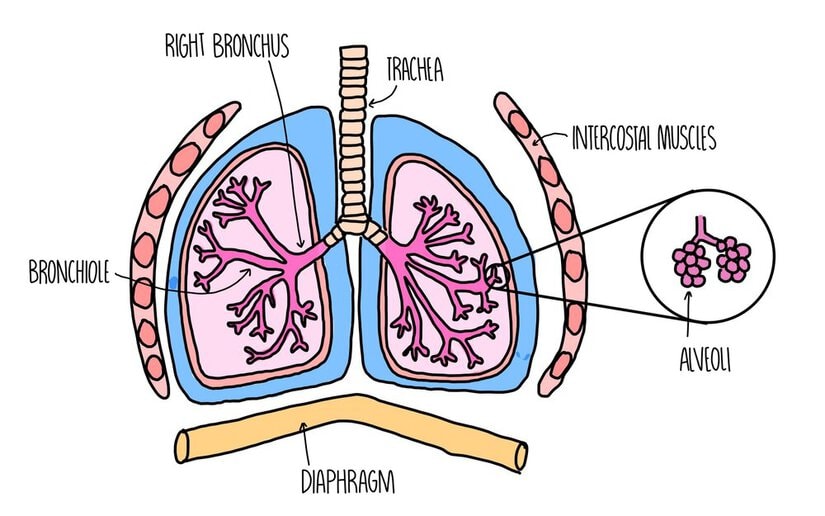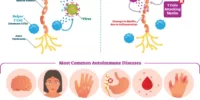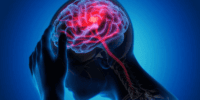Gas Exchange In Respiratory System And Breathing

The respiratory system is responsible for the exchange of gases between the body and the environment.
Oxygen is essential for cellular respiration, the process by which cells produce energy.
The respiratory system works to bring oxygen into the body and remove carbon dioxide, a waste product of cellular respiration.
Gas exchange occurs in the alveoli, tiny sacs within the lungs, where oxygen diffuses into the bloodstream and carbon dioxide is removed.
The mechanics of breathing are controlled by the respiratory muscles and the nervous system.
Inhalation is an active process that requires the contraction of the diaphragm and intercostal muscles, while exhalation is a passive process that occurs when these muscles relax.
Disruptions in the respiratory system can lead to a range of disorders, including asthma, chronic obstructive pulmonary disease, and lung cancer.
Strategies for maintaining healthy respiratory function include avoiding smoking, reducing exposure to air pollution, and engaging in regular exercise.
Key Takeaways
- Gas exchange occurs in the alveoli of the lungs through diffusion.
- Oxygen is transported in the bloodstream dissolved in plasma or bound to hemoglobin, while carbon dioxide is transported in the bloodstream dissolved in plasma or as bicarbonate ions.
- Breathing is controlled by respiratory muscles and the nervous system, with inhalation being active and exhalation being passive.
- Disruptions to the respiratory system can lead to disorders, and maintaining healthy respiratory function includes avoiding smoking, reducing air pollution, and exercising.
The Role of Oxygen in Cellular Respiration
Oxygen plays a crucial role in cellular respiration by serving as the final electron acceptor in the electron transport chain. This electron transport chain is a series of reactions that occurs in the inner mitochondrial membrane of eukaryotic cells. During this process, electrons are transferred from one molecule to the next, ultimately resulting in the production of ATP, which is the primary energy source for living cells. Oxygen is essential for this process because it helps create a proton gradient, which is necessary for ATP synthesis.
In addition to its role in the electron transport chain, oxygen is also involved in the first step of cellular respiration, known as glycolysis. This process occurs in the cytoplasm of the cell and involves the breakdown of glucose into pyruvate. During glycolysis, oxygen is not required, but if it is present, it can enhance the process by allowing for the complete oxidation of glucose. This results in the production of more ATP and NADH, which are both essential for cellular respiration.
Overall, the role of oxygen in cellular respiration is critical for the survival and function of living cells.
Anatomy of the Respiratory System
The human body has a complex network of organs and tissues that work together to facilitate the intake of air and the subsequent transportation of oxygen throughout the body.
The respiratory system consists of the lungs, trachea, bronchi, and alveoli, which are responsible for gas exchange. The anatomy of the respiratory system is specifically designed to maximize the exchange of gases between the body and the environment.
The respiratory system plays a crucial role in maintaining the body’s homeostasis. Its efficient functioning ensures that the body receives an adequate supply of oxygen, which is essential for cellular respiration. The respiratory system also helps in removing carbon dioxide, a waste product of cellular respiration, from the body.
In addition to its physiological functions, the respiratory system also has emotional and psychological significance. The act of breathing is not only essential for survival but also has a calming effect on the mind and body. It can evoke feelings of relaxation, peace, and mindfulness.
The Mechanics of Breathing
During inhalation, the diaphragm contracts and moves down, while the intercostal muscles expand the ribcage, creating negative pressure in the thoracic cavity and allowing air to rush in. This process is known as inspiration.
The diaphragm is a dome-shaped muscle located at the bottom of the lungs. When it contracts, it flattens and moves down, increasing the volume of the thoracic cavity. At the same time, the external intercostal muscles between the ribs contract, lifting the ribcage and further expanding the thoracic cavity. As a result, the pressure in the lungs decreases, and air rushes in through the nose or mouth, down the trachea, and into the bronchi and bronchioles.
Exhalation, on the other hand, is a passive process that occurs when the diaphragm and intercostal muscles relax, causing the thoracic cavity to decrease in volume and the pressure in the lungs to increase. This increased pressure forces air out of the lungs and through the airways, up the trachea, and out through the nose or mouth. In some cases, such as during exercise or when there is a respiratory illness, the body may need to use additional muscles, such as the abdominal muscles, to forcefully exhale.
Overall, the mechanics of breathing involve a complex interplay between muscles, pressure differentials, and air flow, all of which work together to facilitate efficient gas exchange in the respiratory system.
The Alveoli and Gas Exchange
Efficient transfer of gases is essential for the proper functioning of the respiratory process. This transfer occurs in the alveoli, which are tiny air sacs located at the end of the respiratory tree. The alveoli are surrounded by a network of blood vessels, allowing for the exchange of oxygen and carbon dioxide between the lungs and the bloodstream. This exchange occurs through a process called diffusion, where molecules move from an area of high concentration to an area of low concentration.
To understand the importance of gas exchange in the alveoli, here are four key points to consider:
- Oxygen is necessary for cellular respiration, which provides energy for the body’s cells.
- Carbon dioxide is a waste product of cellular respiration and must be eliminated from the body.
The body’s tissues require a constant supply of oxygen, which is transported via the bloodstream.
The lungs must constantly remove carbon dioxide from the body to maintain pH balance in the blood.
The alveoli play a critical role in ensuring that these processes occur efficiently. Their structure and position allow for a large surface area of gas exchange to take place, ensuring that the body’s oxygen and carbon dioxide levels remain within the necessary range for optimal physiological functioning.
The Transport of Gases in the Bloodstream
Optimal physiological functioning relies on the proper transportation of gases in the bloodstream. The oxygen that is inhaled into the lungs from the atmosphere is transported to the tissues and organs via the bloodstream. Similarly, carbon dioxide produced by the tissues is transported back to the lungs for removal from the body. These gases are transported in the bloodstream by two main mechanisms: dissolved in plasma and bound to hemoglobin in red blood cells.
Oxygen is transported in the bloodstream in two forms: dissolved in plasma and bound to hemoglobin. When oxygen is inhaled, it diffuses from the alveoli into the capillaries surrounding them. Oxygen can then dissolve in the plasma and be transported to the tissues. However, the majority of oxygen is bound to hemoglobin in red blood cells, forming oxyhemoglobin. Hemoglobin is a protein that can bind up to four oxygen molecules. This binding is facilitated by a heme group, which contains an iron atom that can form a reversible bond with oxygen. The binding of oxygen to hemoglobin is dependent on various factors, including oxygen partial pressure, pH, and temperature.
Carbon dioxide is also transported in the bloodstream in two forms: dissolved in plasma and as bicarbonate ions. Carbon dioxide diffuses from the tissues into the capillaries and can dissolve in plasma to be transported to the lungs for removal. However, the majority of carbon dioxide is converted to bicarbonate ions in red blood cells via the enzyme carbonic anhydrase. Bicarbonate ions are then transported in the plasma to the lungs, where they are converted back into carbon dioxide for removal from the body.
Gas Exchange in High Altitude Environments
High altitude environments pose a challenge for the human body due to the decreased availability of oxygen, which can lead to various physiological adaptations.
The following are some of the ways in which the body adapts to high altitude environments:
- Increased production of red blood cells: The body increases the production of red blood cells to compensate for the decreased availability of oxygen at high altitudes. This helps to transport more oxygen to the body’s tissues.
- Increased breathing rate: The body increases the breathing rate to take in more oxygen and expel more carbon dioxide. This helps to maintain adequate levels of oxygen in the blood.
- Increased heart rate: The heart beats faster to pump more oxygenated blood to the body’s tissues. This helps to compensate for the decreased availability of oxygen.
- Acclimatization: Over time, the body can acclimatize to high altitude environments by making various physiological adaptations. These adaptations include increased lung capacity, improved oxygen uptake, and improved efficiency in oxygen transport.
- Altitude sickness: Some people may experience altitude sickness when they travel to high altitude environments. This condition is caused by the decreased availability of oxygen and can cause symptoms such as headaches, nausea, and fatigue.
Disorders of the Respiratory System
One of the important topics in the study of human physiology is the various disorders that can affect the respiratory system. The respiratory system is vulnerable to a variety of disorders and diseases that can impair its function and lead to serious health consequences. Some of the most common respiratory disorders include asthma, chronic obstructive pulmonary disease (COPD), pneumonia, and lung cancer. These disorders can result from a variety of factors, including environmental pollutants, infections, genetic predisposition, and lifestyle choices such as smoking.
Asthma is a common respiratory disorder that affects millions of people worldwide. It is a chronic condition that causes inflammation and narrowing of the airways, leading to symptoms such as wheezing, coughing, and shortness of breath.
COPD, on the other hand, is a progressive respiratory disease that is characterized by chronic bronchitis, emphysema, and other lung disorders that make it difficult to breathe.
Pneumonia is an infection of the lungs that can cause fever, cough, chest pain, and difficulty breathing.
Finally, lung cancer is a serious condition that can develop in the cells of the lungs and spread to other parts of the body. Overall, understanding these various respiratory disorders is important for preventing and treating these conditions, as well as promoting overall respiratory health.
Strategies for Maintaining Healthy Respiratory Function
Maintaining healthy respiratory function requires implementing effective strategies that promote lung health and prevent respiratory disorders. The following are four strategies that can help individuals maintain healthy respiratory function:
- Avoid smoking and exposure to secondhand smoke: Smoking is a major cause of respiratory disorders, including chronic bronchitis, emphysema, and lung cancer. Secondhand smoke exposure can also increase the risk of respiratory disorders in non-smokers.
- Exercise regularly: Regular exercise can improve lung function and increase the efficiency of the respiratory system. It can also help maintain a healthy weight, which is important for respiratory health.
- Practice good hygiene: Good hygiene, including frequent hand washing and covering the mouth and nose when coughing or sneezing, can help prevent the spread of respiratory infections.
- Get regular check-ups: Regular check-ups with a healthcare provider can help detect respiratory disorders early and prevent complications. It is also important to follow any recommended treatments and medications for respiratory disorders to maintain healthy respiratory function.
Conclusion
In conclusion, the respiratory system and gas exchange are essential for the survival of organisms. This intricate system involves the inhalation of oxygen and the exhalation of carbon dioxide, which allows for the production of ATP through cellular respiration.
The respiratory system is composed of various structures, including the lungs, bronchi, and alveoli, which work together to facilitate gas exchange. The mechanics of breathing involve the diaphragm and intercostal muscles, which work in unison to regulate air pressure in the lungs.
While the respiratory system is vital for survival, it is also susceptible to disorders such as asthma, chronic obstructive pulmonary disease (COPD), and lung cancer. Therefore, it is crucial to maintain healthy respiratory function through strategies such as avoiding smoking, exercising regularly, and wearing protective gear in high-pollution environments.
Overall, understanding the mechanisms of gas exchange and respiratory function is fundamental to maintaining a healthy body and preventing respiratory disorders.









